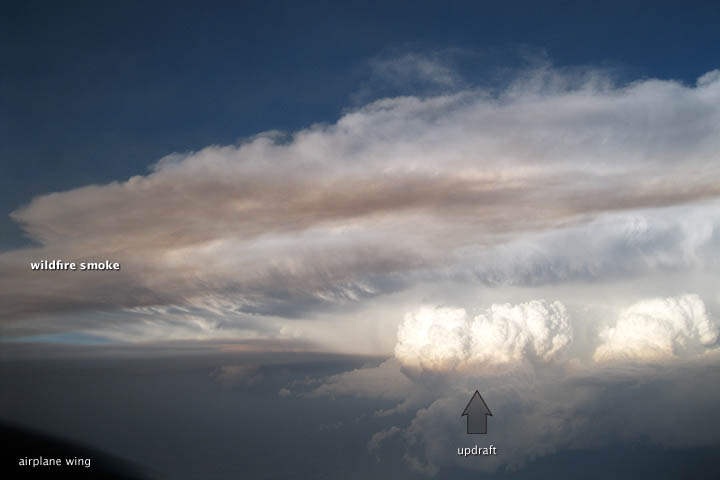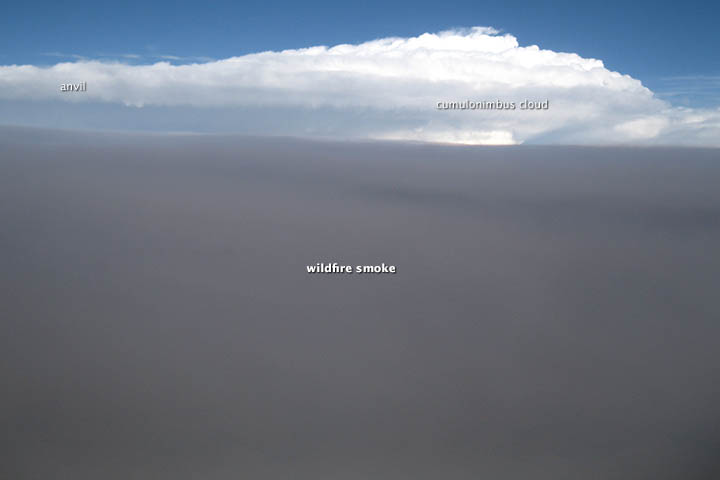NASA: When Wildfire Smoke and Thunderstorms Collide
Posted by Ricardo Marcenaro | Posted in NASA: When Wildfire Smoke and Thunderstorms Collide | Posted on 23:30

acquired June 22, 2012
download large image (553 KB, JPEG, 4000x2667)

acquired June 22, 2012
download large image (398 KB, JPEG, 3384x2256)
Scientists on NASA’s DC-8, a flying laboratory, have concluded a six-week hunt for thunderstorms.
They were part of a team of 100 researchers from 29 organizations who participated in Deep Convective Clouds and Chemistry (DC3), a field campaign based in Kansas that conducted numerous research flights to Alabama, Colorado, and Oklahoma as part of a campaign to understand how storms affect the chemistry of the upper troposphere. The preferred target: large multicell and supercell storms with powerful updrafts capable of lofting volatile pollutants and moisture-rich air nearly 40,0000 feet (12,000 meters) up in the atmosphere, a height that pollutants don’t normally reach without a boost from a storm.
On June 22, 2012, during a flight that proved to be one of the highlights of the campaign, the research team found just the sort of meteorological conditions they had been hoping for developing in northeastern Colorado. The High Park fire, a fast-spreading blaze that had ignited on June 9 and was still burning, had sent a plume of smoke billowing northeast toward Wyoming. Meanwhile, a pair of strong storms had emerged in the general path of the smoke. At points, it looked like the storms might pass north of the smoke plume, but satellite imagery showed the plume heading straight for the storms during the middle of the flight.
According to a summary of the flight posted on the campaign’s website, the DC-8 pilot brought the plane beneath the storm at an altitude of about 9,000 feet and then ascended upward to the storm’s anvil at about 35,000 feet, flying directly through the storm’s core and a visible layer of smoke at around 25,000 feet in the process. The images above, photographs taken by Langley Research Center scientist James Crawford as the plane spiraled past the smoke layer, show the smoke encountering the storm.
The top image shows the smoke layer being partially ingested by an area of strong convection at the storm’s center, a region where the upward pull of convection can suck pollutants upward at speeds up to 100 miles (160 kilometers) per hour. The lower image shows a closer view of the same smoke layer. Numerous instruments aboard the plane were sampling various particles and gases throughout the flight, and they detected extremely high values of carbon monoxide and formaldehyde, pollutants often produced by wildfires.
However, the researchers have only begun to analyze the data collected during this flight—and the 21 others that occurred during this summer’s campaign—in much detail. The last flight occurred on June 30, so the detailed work of sifting through all of the data and publishing noteworthy findings in scientific journals has just begun.
Meanwhile, Crawford says there’s much scientists can learn from unusual cases like the June 22 flight. “In that case, it is important to note that the smoke was already at 20 to 25 thousand feet when it encountered the storm, thus it had to enter the side rather than the bottom,” Crawford noted via email. “Some [scientists] think that the strong core of convective uplift connects the surface to the upper troposphere, but that it is difficult for smoke and other pollutants to penetrate storms from a middle altitude. When we’ve fully analyzed the data, this example will help us understand how effective transport can be for material entering the cloud at mid-atmospheric levels.”
They were part of a team of 100 researchers from 29 organizations who participated in Deep Convective Clouds and Chemistry (DC3), a field campaign based in Kansas that conducted numerous research flights to Alabama, Colorado, and Oklahoma as part of a campaign to understand how storms affect the chemistry of the upper troposphere. The preferred target: large multicell and supercell storms with powerful updrafts capable of lofting volatile pollutants and moisture-rich air nearly 40,0000 feet (12,000 meters) up in the atmosphere, a height that pollutants don’t normally reach without a boost from a storm.
On June 22, 2012, during a flight that proved to be one of the highlights of the campaign, the research team found just the sort of meteorological conditions they had been hoping for developing in northeastern Colorado. The High Park fire, a fast-spreading blaze that had ignited on June 9 and was still burning, had sent a plume of smoke billowing northeast toward Wyoming. Meanwhile, a pair of strong storms had emerged in the general path of the smoke. At points, it looked like the storms might pass north of the smoke plume, but satellite imagery showed the plume heading straight for the storms during the middle of the flight.
According to a summary of the flight posted on the campaign’s website, the DC-8 pilot brought the plane beneath the storm at an altitude of about 9,000 feet and then ascended upward to the storm’s anvil at about 35,000 feet, flying directly through the storm’s core and a visible layer of smoke at around 25,000 feet in the process. The images above, photographs taken by Langley Research Center scientist James Crawford as the plane spiraled past the smoke layer, show the smoke encountering the storm.
The top image shows the smoke layer being partially ingested by an area of strong convection at the storm’s center, a region where the upward pull of convection can suck pollutants upward at speeds up to 100 miles (160 kilometers) per hour. The lower image shows a closer view of the same smoke layer. Numerous instruments aboard the plane were sampling various particles and gases throughout the flight, and they detected extremely high values of carbon monoxide and formaldehyde, pollutants often produced by wildfires.
However, the researchers have only begun to analyze the data collected during this flight—and the 21 others that occurred during this summer’s campaign—in much detail. The last flight occurred on June 30, so the detailed work of sifting through all of the data and publishing noteworthy findings in scientific journals has just begun.
Meanwhile, Crawford says there’s much scientists can learn from unusual cases like the June 22 flight. “In that case, it is important to note that the smoke was already at 20 to 25 thousand feet when it encountered the storm, thus it had to enter the side rather than the bottom,” Crawford noted via email. “Some [scientists] think that the strong core of convective uplift connects the surface to the upper troposphere, but that it is difficult for smoke and other pollutants to penetrate storms from a middle altitude. When we’ve fully analyzed the data, this example will help us understand how effective transport can be for material entering the cloud at mid-atmospheric levels.”
References
- Barth, Mary. (2010). Scientific Program Overview for a Deep Convective Clouds and Chemistry Field Campaign (pdf). Accessed July 10, 2012.
- Brune, B. (2012, June 23). Chief Scientist Summary: June 22 and June 23. Accessed July 10, 2012.
- Crawford, J. (2012, June 23). Science/Operations Report: June 22 and June 23. Accessed July 10, 2012.
- NASA. (2012). DC3: Chemistry of Thunderstorms. Accessed July 10, 2012.
- NOAA. (2012). NOAA, Partners Kick Off Multi-State Study of How Thunderstorms Affect Upper Atmosphere. Accessed July 10, 2012.
Further Reading
- NASA Earth Observatory. (2012, May 26). The Anatomy of a Thunderstorm. Accessed July 10, 2012.
- NSF DC3 Blog. (2012). Deep Convective Clouds & Chemistry: Studying the Role of Thunderstorms in Ozone Production. Accessed July 10, 2012.
Photograph courtesy of the DC3 team and NASA Langley Research Center's James Crawford. Caption by Adam Voiland with information from James Crawford.
- Instrument:
- Photograph
NASA: When Wildfire Smoke and Thunderstorms Collide
Ricardo M Marcenaro - Facebook
Operative blogs of The Solitary Dog:
solitary dog sculptor:
http://byricardomarcenaro.blogspot.com
Solitary Dog Sculptor I:
http://byricardomarcenaroi.blogspot.com
Para:
comunicarse conmigo,
enviar materiales para publicar,
propuestas:
marcenaroescultor@gmail.com
For:
contact me,
submit materials for publication,
proposals:
marcenaroescultor@gmail.com
Diario La Nación
Argentina
Cuenta Comentarista en el Foro:
Capiscum
My blogs are an open house to all cultures, religions and countries. Be a follower if you like it, with this action you are building a new culture of tolerance, open mind and heart for peace, love and human respect.
Thanks :)
Mis blogs son una casa abierta a todas las culturas, religiones y países. Se un seguidor si quieres, con esta acción usted está construyendo una nueva cultura de la tolerancia, la mente y el corazón abiertos para la paz, el amor y el respeto humano.
Gracias :)


Comments (0)
Publicar un comentario